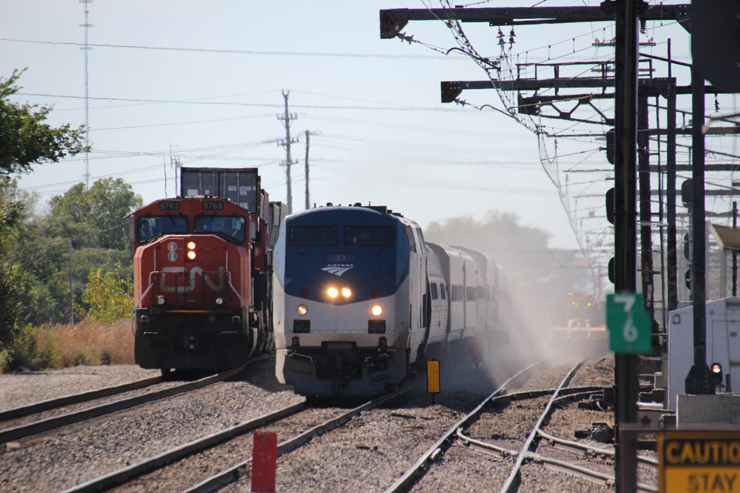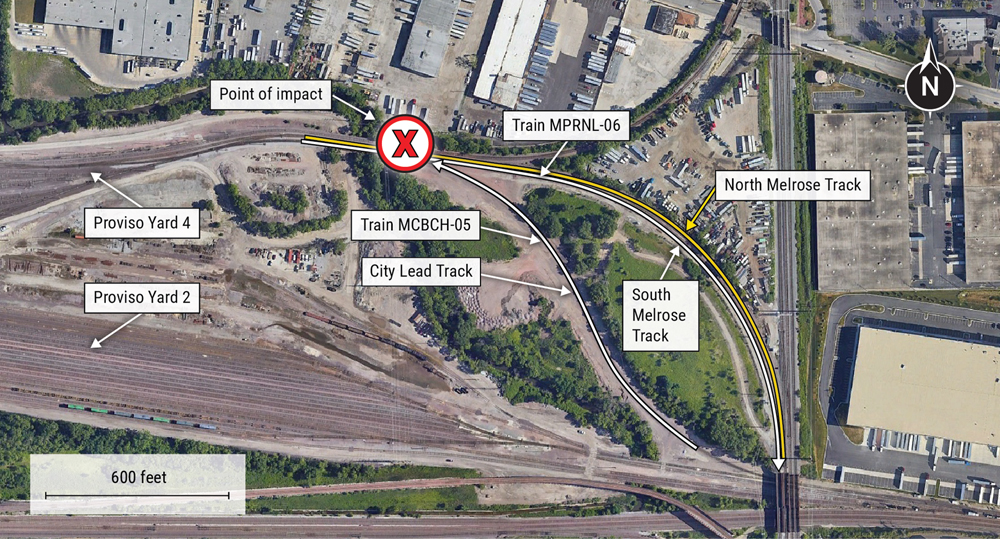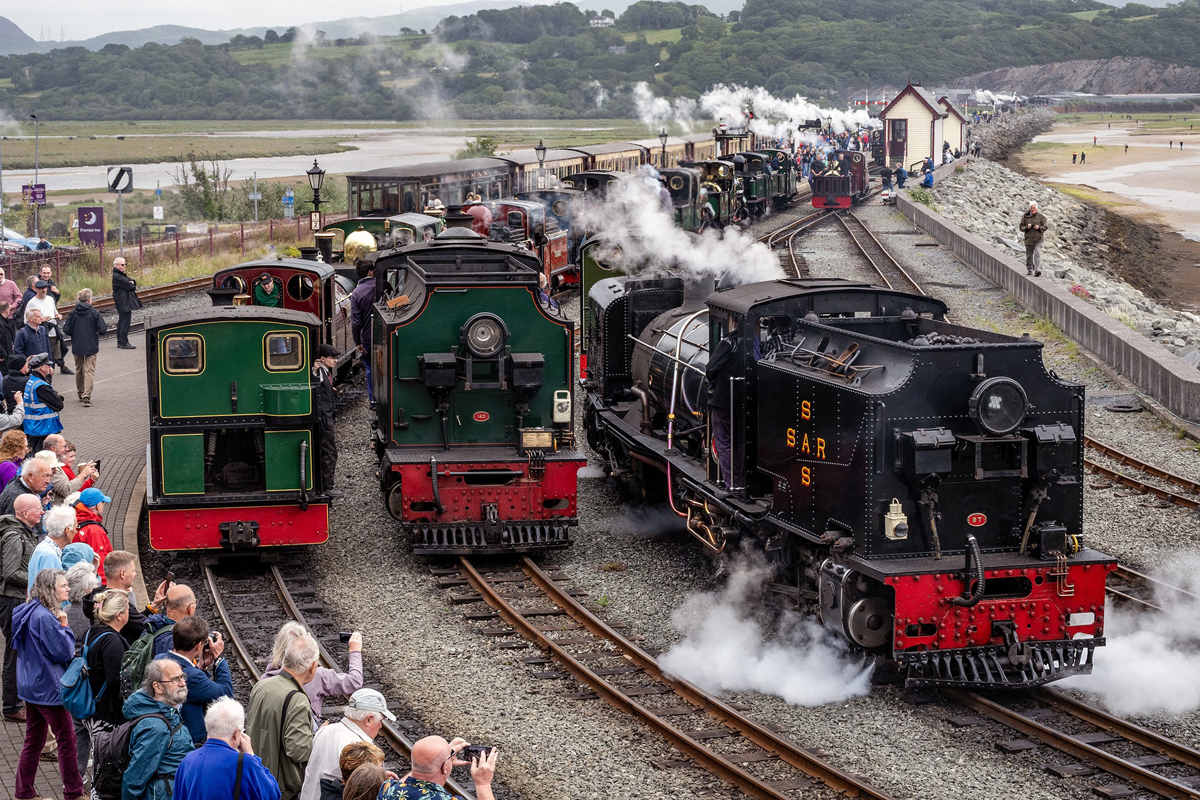
WASHINGTON – Canadian National has rebutted claims that Amtrak and Canadian Pacific have made regarding its proposed acquisition of Kansas City Southern’s line linking Springfield, Ill., with Kansas City and St. Louis.
CN has asked the Surface Transportation Board to force CP to divest KCS’s former Gateway Western Springfield Line as part of the CP-KCS merger. This would allow CN to create a new single-line service route between Eastern Canada, Detroit, and Kansas City.
CN says it would invest $250 million on the line and would ultimately divert 80,000 truckloads to intermodal annually. CN also requested short segments of trackage rights on KCS, particularly to reach its intermodal terminal just south of Kansas City.
Last month Amtrak opposed a divestiture of the line, as CP has all along.
“Amtrak insists that neither the Homewood-Gilman nor the East St. Louis-Godfrey line segments can accommodate an additional 2 or 2.6 trains, respectively, without impairing passenger operations,” CN told regulators in a filing on Friday. “Unlike some other parties participating in the docket, Amtrak presents no capacity analysis or other study supporting its claims.”
CN says its own routine internal analysis shows both line segments have capacity to handle additional traffic.
CN disputed Amtrak claims that in 2015 the freight railroad said its former Illinois Central routes lacked adequate capacity for the state-sponsored Illini/Saluki service.
“CN never alleged that there is insufficient capacity for then-existing or additional freight trains on the Chicago-Carbondale route generally or the Homewood-Gilman Line Segment specifically,” CN told the board, noting that there was a choke point around Champaign due to a combination of limited capacity and the scheduling of the Amtrak trains to meet in Champaign.
CN also aimed to shoot down Amtrak’s complaints that IC should not have single-tracked its Chicago-New Orleans main line in 1988.
“This fact is irrelevant. At the time, ICRR (before it was owned by CN) removed the double track in conjunction with the installation of centralized traffic control, which together with ‘abundant long sidings’ enabled ICRR to run more efficiently while preserving ‘45% extra capacity’ so that ICRR would have no trouble handling additional traffic in the future,” CN said.
CN says that because Amtrak never chose to invest in additional capacity on the IC, it should not be able to block CN’s pursuit of the Springfield Line.
“Amtrak is not entitled to dictate the infrastructure choices of a host railroad,” CN wrote. “Federal law permits a host carrier to abandon excess capacity by downgrading or removing track if Amtrak will not pay the avoidable cost of retaining it. As CN witnesses noted in 2015, although the number of Amtrak trains operating on ICRR’s lines had doubled since 1971, Amtrak never offered to pay to restore the Chicago-to-New Orleans route to double track.”
Amtrak cherry-picked statistics regarding poor on-time performance of passenger trains operating on CN’s former IC, CN says, pointing out that CN freight trains accounted for only 19% of the 517 hours of delay reported on the Illini/Saluki service in 2019. CN and Amtrak have a long-running dispute over the performance of passenger trains on the former IC.
CN also told the board that if it needed proof that its purchase of the Springfield Line would boost competition that regulators should look no further than a statement from CP CEO Keith Creel.
Creel, in an earlier filing with the STB, said a forced sale of the Springfield Line to CN would allow CN to “poach some of the traffic opportunities that CPKC would otherwise pursue in the Kansas City-Chicago lane.”
Although it does not plan capacity improvements on the line, CP has said that the former Gateway Western trackage would be an integral part of the combined CPKC system.
CN Chief Marketing Officer Doug MacDonald wrote that the railway has long had an interest in the Springfield Line and has considered options that would allow CN to invest in upgrades that would allow a joint CN-KCS route to reach its full potential. Details about CN’s interest in the line were redacted, however.
“In contrast to CP’s likely neglect of the Springfield Line, I believe — and the evidence in the record of this proceeding further supports — that CN is uniquely situated to transform the Springfield Line into a force to be reckoned with over this corridor. No other railroad has the incentive to invest in the Springfield Line,” MacDonald wrote.
When CN was KCS’s proposed merger partner last year, the railways touted the potential of what they called the Springfield Speedway.
CN disputed CP’s claims that three years ago CN sought to shut down its KCS interchange at Springfield in favor of a roundabout route to East. St. Louis, Ill.
The interchange was relocated solely because there wasn’t enough capacity at Cockrell, Ill., just outside of Springfield, to handle merchandise traffic. Sending more traffic through the interchange, CN said, would interfere with operations to serve the major ADM facility at Cockrell.
The Springfield Line interchange remains open, CN says, even as it continues to route KCS interchange traffic via East St. Louis, which adds 175 miles each way.














I agree that the KC line has value now. The question is why should it be handed over to CN as price for them to sign on to the merger when KC is not on CN’s route map now? To get a pound of flesh out of CP? This is the opportunistic part of this. CPKC is not expanding its footprint. They will become one operation in KC. That is it as far as reduction of competition and since the two reach KC by opposite directions, what is the actual reduction?. Why should CN be allowed to infringe where it isn’t now when CPKC is.
And it is correct that myriads of railroads have tried to bypass Chicago. All of those attempts have been abject failures, because all of the railroads were geared toward Chicago (or St. Louis or Memphis or Kansas City or New Orleans) handling the interchange traffic. Everywhere else was simply a sideshow that required two managements to be enthusiastic about it, not just one. That didn’t and generally doesn’t happen. And it requires additional infrastructure that costs money to become a full-fledged interchange point. And that didn’t happen, either. And the railroads all still pay dues to the terminal railroads in the traditional interchange points whether they try to bypass those points or not. That is why Chicago (and St. Louis) remains.
Once the 75th Street project is finished in Chicago, we will get to see how all of the money for CREATE actually helped. And since the railroads all chipped money in on the CREATE program, they are going to expect to get some return for it, including CN.
Chicago will not go away until we have nationwide mergers and the revenue splits will be a moot point. And that may never happen.
CN doesn’t want to interchange with BNSF or UP to reach KCMO because their logistics hub is on KCS. So they are compelled to use KCS to get their traffic in and out of that hub.
But because KCS hasn’t been investing in the Springfield Sub west of CP Cockrell and essentially treating it like a branch line, KCS sends CN traffic through a 173 mile out of the way route via Godfrey.
This is obviously bothering CN and so they want to run it themselves without CPKC in the way.
If I was CN, I would simply ask the STB to compel CPKC to upgrade the route so they can get better routing into and out of KCMO. In return make it worth for CPKC to upgrade the sub by offering a route to a Chicago bypass.
I am confused. I have looked at CN’s website and they do not display any logistics hub for themselves anywhere close to Springfield or Kansas City or anywhere on that line, or that they partner with anyone for a logistics hub.
KCS only shows transloads at KC, one at Godfrey, and two in East St. Louis.
Where exactly is this hub? Is it IFG in South KC? Why don’t they advertise they have that connection? And how many trains a day does it encompass? Is there enough traffic from the hub to justify upgrading the line? One or two trains per day is not enough.
To those who say IC didn’t develop it when they had it, I can only say IC didn’t have a 3 ocean railroad at the time. At least not until they became CN. Now that they are CN, the KCMO route has value.
As for the Chicago bypass equation, I call out baloney on all the Class 1’s.
How many attempts for a Chicago bypass have been attempted?
Santa Fe bought the TPW so they could interchange with eastern railroads at Logansport, Indiana and if it had gone through with Erie Lackawanna a few miles northeast. No one would route traffic. Santa Fe dropped the line and it still is a marginal line.
How long has NS owned the Wabash route to KCMO? Nope, no one who terminates in Chicago wants to give up those last few hundred rail miles. They would rather get that last penny of revenue than deal with any Chicago congestion…..that is someone else’s problem. Customer be damned.
CN bought EJ&E to avoid north-south congestion, not east-west that plagues everyone else.
BNSF used to go as far as Alabama coast on the old Frisco. Now they only go to Birmingham, prime interchange? Hardly. They pulled back and spun it off.
BNSF intersects with CSX twice in Illinois via the Beardstown Sub. Do you see massive amounts of interchange? No, they drag it all the way down to St Louis and force it to tangle with the Alton & Southern.
Chicago issues won’t become irrelevant until all Class 1’s meet somewhere else, and right now, that doesn’t exist.
“CNR, CPKC, CSX and NS need to sit down together and sort out their routes.”
Excellent point Charles, they all complain about Chicago, here’s an opportunity to do something about it.
Forgive me posting the same thing for about the fifth time. I can look at a map and wonder what’s up with CPKC not having a direct route from West Detroit to KCMO. Chicago congestion aside, Toronto/ Detroit to KCMO via Bensenville is indirect as measured by miles. Therefore, it’s both of them, CNR and CPR that need to reshape the map south of Chicago and into Michigan.
Remember in TRAINS MAGAZINE in the 1970’s into the 1980’s? Repetitive coverage of the supposed duplicative routes in Indiana and Ohio. Well, now it’s not excess capacity, it’s a shortage of capacity. Anyone who reads TRAINS MAGAZINE has to know that the lack of a south Chicagoland bypass is one of the biggest problems in American railroading. This should have been sorted out a generation ago. John Knieling discussed the issue but came up with the wrong answers, like all other topics he ranted about.
CNR, CPKC, CSX and NS need to sit down together and sort out their routes. Before Martin Oberman does it for them.
Are these negotiations already happening behind closed doors? Maybe. But CNR’s nonstop whining in public doesn’t help.
It is hard to see at this point that CP and CN would sit in the same room to cooperate on something like that, even though it is the smart thing to do. NS has their own route from Detroit to Kansas City and Chicago isn’t even close to that. They can tout that while CN and CP are fighting over their issues.
If EJ&E had looked beyond just being an interchange loop, they could have become part of a south Chicagoland bypass. I doubt CN is interested in that anymore.
Mr. Dick: What I see CN wants is a relatively congestion-free route for KC-eastern Canada traffic that bypasses Chicago via the big interchange they built for themselves at Matteson, IL. Eastbound trains go seamlessly to CN’s former EJ&E at Matteson and to CN’s former GTW at Griffith, IN. And after they cross NS at South Bend they are home free. Perhaps that routing, that bypasses the Chicago congestion CP must drive through to get to the IHB at Bensenville and the BRC at Cicero, would entice western carriers to go for the KC handoff. Their shippers, seeing reduced transit times gained by shippers who took a gamble with CN, might demand it.
Mr. Shapp.
Yes, you are correct, that is the routing they want. But the access they really want is to get into Kansas City unfettered, when their predecessor IC never saw fit to develop it as a market for themselves in the first place. They want to bypass Chicago and then expect KCS to hand them Kansas City at the same time. It is called having your cake and eating it, too.
Yes, CN customers may demand better service to Kansas City. Who says they have an unfettered right to it?
CPKC will still not have Memphis, and their St. Louis connection is over the same line that CN wants to grab from them. So when CN gets that line and takes control over the dispatching, who is going to get the screws put to them with both their St. Louis traffic and the other traffic they have on that line when they own it now?
CN has had a very strident attitude over this whole thing acting like they have a complete right to this. No, they don’t. Their predecessor gave up that right when they sold the line 35 years ago, and simply because they came back with a knee-jerk reaction trying to take over KCS after CP beat them to the punch doesn’t mean they get to somehow force CPKC to hand them a piece of railroad which they do not have any historical context to back it up, other than IC could not make it work, or were too disinterested to try to make it work.
Trackage rights; maybe. Switching ownership; bad plan. And CN better plan on building its own facilities in Kansas City because their isn’t a lot of spare capacity at any Kansas City facility for someone new to come to town.
CN still crying. Sad
How many cracks at owning this line does IC get? They owned it when they merged with the GM&O and dropped it because it had little traffic on it. And it has been through some ownership changes (SP, GW, KCS) since that happened and it still didn’t have much traffic on it. Notice how that has not been brought up by CN. KCS owned it before CN was merged with IC. And I dare say it probably has the same rail on portions of it when IC got rid of it.
Now CN acts like they can’t live without it and act like they have some sort of special right to own it. There is no reduction in competition on that line if CPKC keeps it. So why should CN get it? They also haven’t said what they are willing to compensate CPKC for it either. Just that they will pump a bunch of money into it when it is theirs. And they expect to be able to use all of the KCS facilities in KC at the same time.
CN needs to find another way into KC if they want to get there. Being as KC is the no. 2 interchange point in North America and faster than Chicago they realize that nothing good will happen for them out of this. Looks like they got outmaneuvered. Let’s see what kind of consideration they get for their “needs” to grab a chunk a railroad that appears extremely opportunistic.
CN wants this to be able to bypass interchange in Chicago for traffic to/from points east or west of Chicago. The problem is which western railroad is going to sacrifice revenue by trading off at KC instead of Chicago?
And yes, KCS ONLY uses the Jacksonville line to access a grain elevator but every time I drive by there a train is there. It isn’t just for harvest season. That elevator is good revenue.
Amtrak-CN dispute overflowing into the merger hearings.
KCS *does* have a vested interest in their Springfield Line. They have invested in the proposed Jerseyville Logistics Center. Even IDOT has been updating US-67 in anticipation of the truck traffic they expect KCS to facilitate. The problem is actually farther east.
“The Springfield Line interchange remains open, CN says, even as it continues to route KCS interchange traffic via East St. Louis, which adds 175 miles each way.”
Why? Because KCS only uses the line to get to an ADM mill at CP Cockrell and a ADM elevator farther west. Essentially a connected branch line. The line to Jacksonville, IL is for a single elevator complex. This KCS Springfield Sub is old jointed rail and many of the bridges look pretty decrepit for any kind of high volume operations. No wonder CN is licking its chops and wants to invest in it. KCS routes CN traffic via Godfrey because this line desperately needs an upgrade, and CN is willing to fund it.
I get what CN is after and why they are picking on KCS for this line, but an earlier poster recommended some kind of trading of rights between the two to help CPKC reach Clearing from the south.